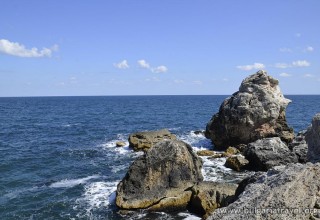2 km away from Kamen bryag is Yaylata National Archaeological Preserve, where a number of archaeological discoveries have been made. It is a coastal terrace with an area of 300 decares, separated from the sea by rock massifs with a height of 50-60 m.
A small fortress is situated on the northern part of the plane terrace known as the Big Yayla. The place it was built on, slightly dominates over the surrounding terrain and is separated from the sea by 20 m high rocky cliffs to the north and east. Thus fortification walls were needed only to the west and south. These are 2.60 m wide, with total length of 130 m. Facing the mainland, four solid towers are placed in front of the western fortification wall, and the gate to the fortress was located in the southern end of the southern fortification wall. The faces of the defense constructions were precisely built from closely fitting stone blocks, which at some places are 2.00 m long and 0.70 m wide. In the inside there are three stairs closely attached to the fortification wall, which are in a good state of preservation. They were positioned in such a way as to allow fast and easy access to the platforms of the walls and the towers. A small area from the interior of the fortification settlement has been excavated and investigated. The main street has been cleared leading from the gate to the fortress center and a large-sized building, probably the sentinel premises. Stone stairs closely fit to one of the building indicate that this was a two-storey construction.
The gate would have been the most neuralgic and most important spot for the functioning of the fortress. It is a tower-type gate with two entrances, each 2.60 m wide. The outer entrance was barred by a descending cataracta, and the inner entrance had a two-winged door barred with massive beams that glided into deep grooves made for this purpose into the fortification wall. The entrance arch was watched over by a tower, which provided better guard for the entrance gate and the surrounding area.
The various archaeological artifacts made from copper, bronze, bone and clay and numerous coins found there indicate that the fortress was built at the end of the 5th – beginning of 6th century A.D. Existing during the time of some of the most devastating raids of the Slavs and proto-Bulgarians, the fortress was short-lived. It was finally destroyed in the last quarter of the 6th century and the settlement survived the burned ruins of the fortification for another couple of centuries. A Proto-Bulgarian settlement emerged there as late as the 9th century. At that time the entrance gate was blocked with a wall of secondary-used stone blocks and a small temple was built at the fmall gate in the western wall. Similar to the fate of most settlements in the Dobroudja region, this one too was destroyed by the invading Pecheneg tribes at mid-11th century. After that time life entirely ceased at this place.
EU funded project entitled “Yailata – the Ancient Door of [the Region of] Dobrudzha" helped the restoration of the fortress walls of the Byzantine fortress, the reinforcing of the St. Constantine and St. Helena Rock Church, the [building of a] watch tower with a telescope, and many other activities. A total of BGN 2.2 million (app. EUR 1.1 million) of EU money from Operational Program “Regional Development" were invested in the project.
Availability for visits: Yes, Paid
Tourist infrastructure: Tourist Information Centre, parking lot







